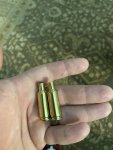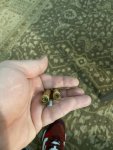Hey guys, FNG here....
I have talked to a lot of people I have a lot of respect for, and it is funny how polarizing this issue seems to be. I know people squarely in both camps. Some people are set on using no lube on the necks or bullets for seating, and others use moly powder or graphite powder on either the necks or the bullets before seating.
Assuming one could ensure there was no powder contamination, why or why not should you lube necks or bullets when seating them?
Believe me, I have used the search function, and the responses are always split. Any real updated insight will help.
Thanks ahead of time for the replies.
Chad
I have talked to a lot of people I have a lot of respect for, and it is funny how polarizing this issue seems to be. I know people squarely in both camps. Some people are set on using no lube on the necks or bullets for seating, and others use moly powder or graphite powder on either the necks or the bullets before seating.
Assuming one could ensure there was no powder contamination, why or why not should you lube necks or bullets when seating them?
Believe me, I have used the search function, and the responses are always split. Any real updated insight will help.
Thanks ahead of time for the replies.
Chad



